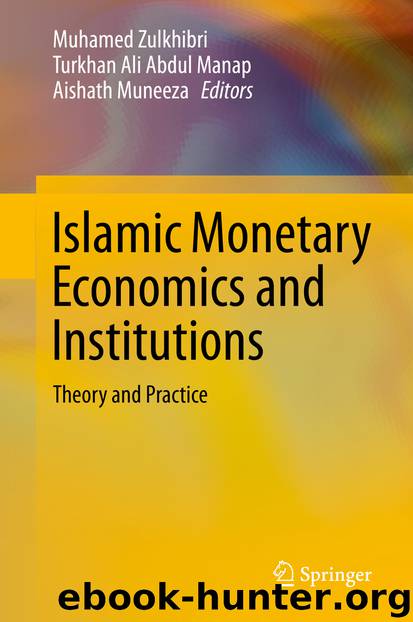Islamic Monetary Economics and Institutions by Muhamed Zulkhibri & Turkhan Ali Abdul Manap & Aishath Muneeza

Author:Muhamed Zulkhibri & Turkhan Ali Abdul Manap & Aishath Muneeza
Language: eng
Format: epub
ISBN: 9783030240059
Publisher: Springer International Publishing
6.2 Literature Review
Some of the other problems faced by adopting the risk-sharing finance are the risk of fraud, taxation system and highly complex nature of equity financing. For example, Sudan Islamic Bank in the application of Musharakah indicates that Islamic banks find it difficult to identify sound financing opportunities and expensive to employ specialists for financing. One of the dominant factor in the low level of application of Musharakah is the moral hazard (Khan 1995; Aggarwal and Yousuf 2000; Ahmed 2005). Dar and Presley (2000) argue that an imbalance between management and control rights is attributed as a major cause of lack of PLS in the practice of Islamic finance. Given this dichotomy, the agency problem gets accentuated, which may put the PLS at a disadvantage vis-à-vis other mode of financing. However, there is no theoretical reason to believe that PLS is inherently inefficient.
Iqbal and Llewellyn (2002) viewed that the most influential factor in the marginal application of Musharakah model is asymmetric information, which is the result of adverse selection and moral hazard problems. They also point out that the reduction of information asymmetry is a prerequisite for the implementation of an equity-based system. Ahmed (2005) describes three major areas where the Islamic banks find it difficult to finance under the PLS system, they are (i) participating in long-term and low-yield projects, (ii) financing the small businesses and (iii) granting non-participating loans to running businesses. Financing under the equity participation method is most risky for banks in developing countries due to major reasons such as lack of proper accounting, honesty, integrity and character of investors, insufficient number of skilled entrepreneurs and the presence of contrary laws and regulations.
Highlighting the importance of PLS-based financing, Chapra (2007) emphasizes that the socioeconomic benefits of the prohibition of interest may not be realized fully until the share of PLS modes rises substantially in total financing. It would hence be desirable for the use of PLS modes to gain momentum. However, Islamic bank faces operational difficulties, business ethics, bad projects with high-risk and overoptimistic prospective profit figures, lack of special regulatory framework, inefficient procedures and low level of expertise, high monitoring cost, inefficient tax system and high rate of illiteracy are some of formidable obstacles in the practical scope of PLS instruments. Chong and Liu (2009) mention several possible reasons for the poor adoption of the PLS paradigm in practice, like PLS financing encounters severe principal–agent problems, moral hazard problems associated with ex-post information asymmetry. The adoption of the PLS paradigm is constrained by competition as well as by best practices from conventional banking. Accordingly, PLS financing requires more costly monitoring.
Shinsuke (2010) indicates that from the viewpoint of microeconomics, the use of partnership-based instruments in Islamic finance get involved in the incentive problem, which implies that the use of partnership-based instruments cannot result in the most efficient solution owing to the asymmetry of information which further leads to adverse selection in the period before a contract is entered into and moral hazards in the period after a contract is entered into.
Download
This site does not store any files on its server. We only index and link to content provided by other sites. Please contact the content providers to delete copyright contents if any and email us, we'll remove relevant links or contents immediately.
International Integration of the Brazilian Economy by Elias C. Grivoyannis(57399)
The Radium Girls by Kate Moore(10922)
Turbulence by E. J. Noyes(7059)
Nudge - Improving Decisions about Health, Wealth, and Happiness by Thaler Sunstein(6644)
The Black Swan by Nassim Nicholas Taleb(6205)
Pioneering Portfolio Management by David F. Swensen(5617)
Rich Dad Poor Dad by Robert T. Kiyosaki(5170)
Zero to One by Peter Thiel(4838)
Man-made Catastrophes and Risk Information Concealment by Dmitry Chernov & Didier Sornette(4751)
Secrecy World by Jake Bernstein(3791)
Millionaire: The Philanderer, Gambler, and Duelist Who Invented Modern Finance by Janet Gleeson(3576)
Skin in the Game by Nassim Nicholas Taleb(3484)
The Age of Surveillance Capitalism by Shoshana Zuboff(3433)
The Money Culture by Michael Lewis(3293)
Skin in the Game: Hidden Asymmetries in Daily Life by Nassim Nicholas Taleb(3275)
Bullshit Jobs by David Graeber(3192)
The Dhandho Investor by Mohnish Pabrai(3177)
The Wisdom of Finance by Mihir Desai(3088)
Blockchain Basics by Daniel Drescher(2897)
